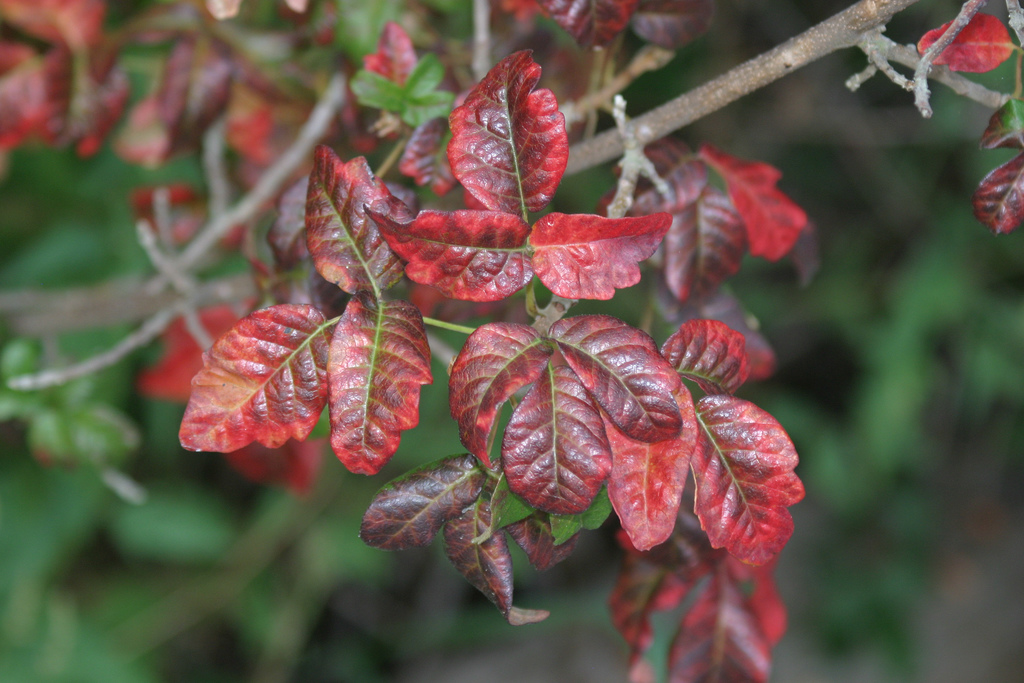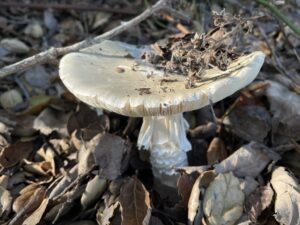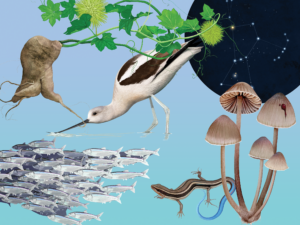by Joe Eaton and Ron Sullivan
Nature writers Joe Eaton and Ron Sullivan took a hazardous assignment for our summer issue: Get up close and personal with poison oak. Be sure to check out their forthcoming summer feature (subscribe by June 21 to get it soon after!) Meanwhile, here’s a few of their favorite tales of poison oak woe, and a video to help you ID the one native plant everyone loves to hate.
Our informal poll of people who spend a lot of time outdoors turned up some harrowing stories of poison oak experiences.
Artist/naturalist Jack Laws got a lasting souvenir: “Some years ago at the Walker Creek Ranch in Marin County, a massive dangling poison oak vine blocked a trail. One afternoon I got a saw and cut the base of the vine — a good four inches across. In a stroke of genius, I climbed up the tree, grabbed onto the vine, and jumped out of the tree, and as it came loose, I was lowered gently to the ground fifteen feet below. Success? Almost… The entire foliage of the vine followed as well. I was swimming in crimson leaves. I came down with a whopper of a dermatitis case. My clothes developed permanent jet black spots and streaks where the sap had rubbed against me. Those pants always reminded me of the black patterns painted on some California Indian baskets.” (The fruit of an Asian relative of poison oak was once used to make indelible laundry marks.)
Schoolteacher Becky Lum of Pinole described a close encounter. On a hike to Little Yosemite in Sunol Regional Wildnerness, her aging dog Zeke balked at climbing a huge boulder. He was too heavy to carry. “With trepidation (well, mine anyway), we detoured around the boulder, Zeke charging poison oak thickets on the hill. I could only imagine the oils in his fur. I had to grab the long stalks draping down the hillside. What would a rash on the palms be like? Visions of swelling and itching for weeks haunted my drive home. Thorough and immediate washing with Tecnu saved me: no rash and only minor psychosomatic itching.”
A search and rescue volunteer, who requested anonymity: “Typically I get it on my forearms because of my dog. She gets the oils on her fur, particularly her underbelly, and then I lift her into the car. Once, on a body recovery, I managed to get it through my thick pants all down the backs of my legs. The worst I ever got was on my face and in my eyes four years ago. The itch was unbearable, one eye swelled totally shut, the other eye half shut, and my head swelled grotesquely. I couldn’t drive, read, or work on a computer, so for the next eight days I ate a meal, took a pill, and went back to sleep. The poison oak just had to run its course; nothing was going to speed the process up.” Now her post-search routine includes showering with Dawn—more effective than Tecnu, she says–and wiping down gear with alcohol.
There were also even worse tales: Years ago, Joe heard a friend-of-a-friend story about a Southern California Boy Scout troop on a survival weekend in the woods. The scouts were encouraged to use natural plant material for shelter, food, whatever else they needed. Unfortunately, they lacked either adult supervision or a plant guide. Poison oak leaves, they learned, are not a satisfactory substitute for toilet paper.
You can take a tour of horrors over on Flickr by searching “poison oak rash”, or you can invest 3 minutes in this Youtube video to help you hone your PO ID skills:
http://www.youtube.com/watch?v=GFnSPIkgr2M
But don’t let the threat of poison oak keep you indoors! Several respondents had never had a reaction. “I’ve even bushwhacked through it,” says birder Rusty Scalf. “I seem to be completely immune.” Lucky him. As for the rest of us, just watch your step.





